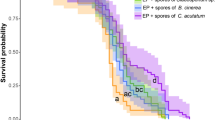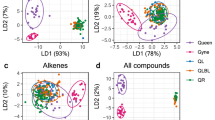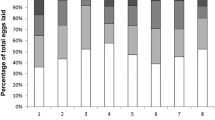Abstract
IN the course of work on the social organization of honeybee communities1, it has been found that worker honeybees obtain a substance (‘queen-substance’) from their queens which, if obtained in sufficient quantity, inhibits development of their ovaries and the production of further queens. It will also, under experimental conditions, inhibit ovary development in worker ants (Formica fusca) (unpublished work, C. G. B.). A similar hormone has been shown to inhibit ovary development in decapod crustaceans2. These substances appear to be similar in several respects. Thus both are stable to heat and to acids but less so to alkalis, soluble in acetone and alcohol, both are active, at least under certain conditions, when taken orally, and both serve to inhibit development of the ovary and related phenomena.
This is a preview of subscription content, access via your institution
Access options
Subscribe to this journal
Receive 51 print issues and online access
$199.00 per year
only $3.90 per issue
Buy this article
- Purchase on Springer Link
- Instant access to full article PDF
Prices may be subject to local taxes which are calculated during checkout
Similar content being viewed by others
References
Butler, C. G., Trans. Roy. Ent. Soc., Lond., 105, 11 (1954).
Carlisle, D. B., Publ. Staz. Zool. Napoli, 24, 355 (1953).
Author information
Authors and Affiliations
Rights and permissions
About this article
Cite this article
CARLISLE, D., BUTLER, C. The ‘Queen-Substance’ of Honeybees and the Ovary-inhibiting Hormone of Crustaceans. Nature 177, 276–277 (1956). https://doi.org/10.1038/177276b0
Issue Date:
DOI: https://doi.org/10.1038/177276b0
This article is cited by
-
Honeybee queen mandibular pheromone fails to regulate ovary activation in the common wasp
Journal of Comparative Physiology A (2022)
-
Sexual response of male Drosophila to honey bee queen mandibular pheromone: implications for genetic studies of social insects
Journal of Comparative Physiology A (2017)
-
A queen bee extract (Apis mellifera L.) (Hymenoptera) reduces the fecundity ofTenebrio molitor L. (Coleoptera)
Experientia (1982)
-
Recherches sur la biologie et l'éthologie deDolichoderus quadripunctatus (L.) (Hym. Form. Dolichoderidæ)
Insectes Sociaux (1968)
-
Effect of Synthetic ‘Queen Substance’ (9-oxodec-trans-2-enoic acid) on Ovary Development of the House-fly, Musca domestica L.
Nature (1963)
Comments
By submitting a comment you agree to abide by our Terms and Community Guidelines. If you find something abusive or that does not comply with our terms or guidelines please flag it as inappropriate.



